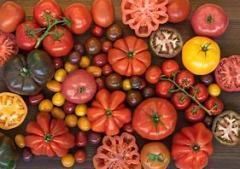MAINE-LY GARDENING: What’s in the garden? Tomatoes
 by Jude Hsiang
by Jude Hsiang
Six months ago, when gardeners began to dream of summer and pour over seed catalogs, tomatoes were at the top of many wish lists. Now those gardeners are tending their plants and watching as the little yellow flowers begin to develop into what the botanists call berries, but most of us think of as vegetables. Salads, soups, pastas, pizzas…what other plant offers so many delicious possibilities?
Tomatoes have such a prominent place on our tables and in our pantries that we sometimes forget that these plants originated in South America. When tomatoes were first brought back to Europe by early explorers, many people were skeptical of stories that people actually ate them. After all, the flowers revealed that tomatoes are part of the nightshade family, so it’s not surprising that they were first grown as ornamental plants in Europe. Other members of the nightshade family include potatoes, peppers, eggplant, even petunias and tobacco. When tomatoes were first introduced to China, people called them “foreign eggplants” as they also recognized that the flowers looked like those of that familiar native plant.
As agriculture became big business over the last hundred years and improved transportation meant tomatoes could be shipped over thousands of miles in days or hours. The focus was on quantity, uniformity, and ease of shipping that sometimes outweighed taste.
More recently, gardeners have sought out “heirloom” varieties of tomatoes, as well as other foods, which were developed in small farms and backyard gardens. These types might have special qualities of taste or uses that make them more desirable than the “one-size-fits-all” tomatoes that were trucked to our supermarkets from far away farms. Heirloom tomatoes like Brandywine, a favorite for its sweetness, have the advantage that their seeds can be saved for the following year’s crop, unlike hybrid tomatoes that don’t reliably produce the same characteristics. And heirloom tomato varieties can be interesting colors when ripe, including orange, green, and purple.
Modern tomatoes come in a wide variety of shapes, sizes, colors, and uses. Some gardeners grow one type, perhaps the large juicy “beefsteaks” that provide nice big slices for BLTs. Other folks, with larger gardens and appetites, grow several kinds, and enjoy experimenting with different varieties each year.
What sort of tomatoes to grow? There are the typical red, round, “globes” for all around goodness – smaller than the big beefsteaks. Paste, or Roma tomatoes are great for sauces and canning. Smaller cherry, grape, or pear tomatoes are especially nice in salads, and some varieties are orange or yellow instead of the familiar bright red. These are especially fun for kids to grow and eat.
Tomato plants are perennials in their original tropical homelands, and it can be fun to grow long vines over years in a heated greenhouse. For most gardeners, the choice may be between smaller “determinate” plant types which are smaller, bushier, and produce a lot of fruits over a shorter time. Or they may want an “indeterminate” vining type that takes more room but continues to produce until frost. The University of Maine Cooperative Extension suggests tomatoes of the various kinds that do best in our climate. Whichever kind you may be growing or buying this season, try a few others from a farm stand, farmers market, or a friend’s garden. You may discover a variety or two that you’ll want to grow next year.
© Judith Chute Hsiang
Jude Hsiang Is a retired Extension Master Gardener instructor and member of the China Community Garden.
Responsible journalism is hard work!
It is also expensive!
If you enjoy reading The Town Line and the good news we bring you each week, would you consider a donation to help us continue the work we’re doing?
The Town Line is a 501(c)(3) nonprofit private foundation, and all donations are tax deductible under the Internal Revenue Service code.
To help, please visit our online donation page or mail a check payable to The Town Line, PO Box 89, South China, ME 04358. Your contribution is appreciated!



Leave a Reply
Want to join the discussion?Feel free to contribute!